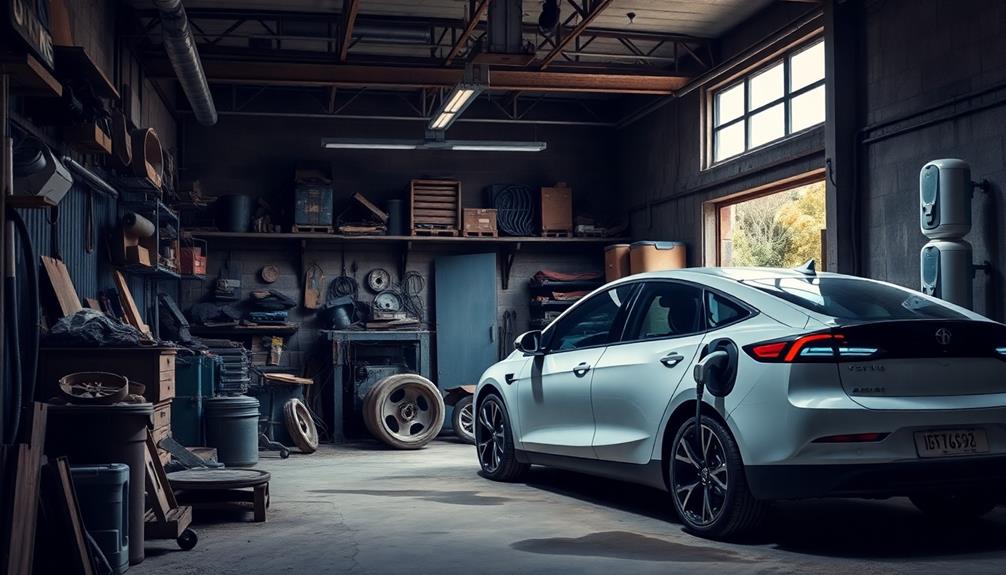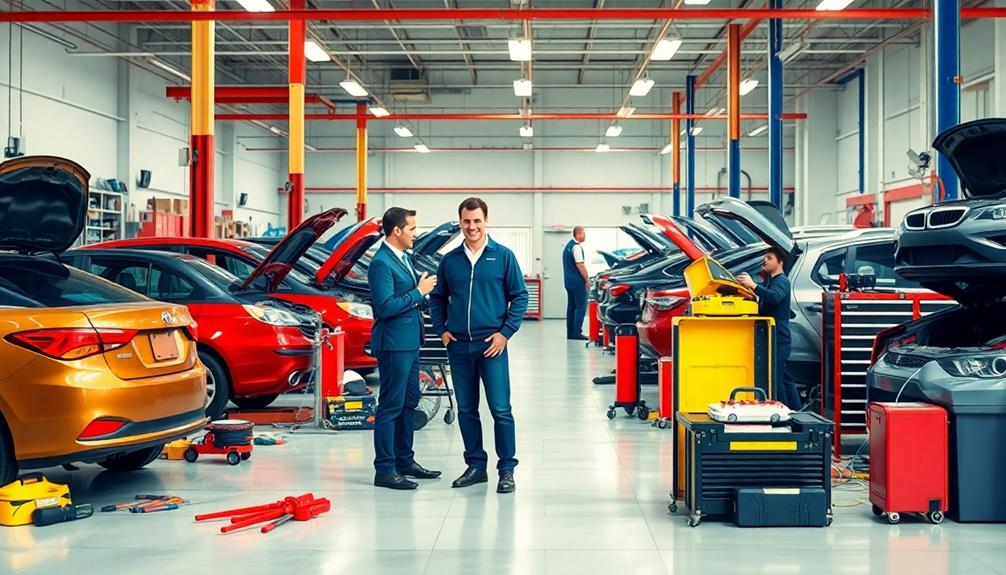The automotive repair industry isn't dying, but it's definitely facing serious challenges. With over 100,000 new technicians needed each year and a repair backlog that's grown substantially, your local shops are struggling to keep up. Although vehicle ownership remains high, post-pandemic issues like rising costs and supply chain constraints complicate repairs. Plus, the increasing complexity from electric vehicles demands new skills and training. Yet, the high demand for repairs shows there's still life in the industry. There's much to explore about how these factors shape the future of automotive repair and what it means for you.
Key Takeaways
- The automotive repair industry is not dying; it is projected to grow, with the aftermarket auto industry valued at $17.5 billion and expected to reach $20 billion by 2028.
- There is a significant technician shortage, requiring over 100,000 new technicians annually, which poses challenges for the industry's future.
- The average age of vehicles in the U.S. exceeds 12 years, increasing the demand for repair services as mechanical issues become more common.
- The rise of electric vehicles introduces complexity, necessitating specialized training for technicians, which could support job growth in the field.
- While economic pressures and rising repair costs are challenges, the ongoing vehicle ownership and repair demand indicate a resilient industry.
Overview of the Automotive Industry

The automotive industry is thriving, and it's hard to ignore its importance in everyday life. With approximately 92% of American households owning a car, the demand for reliable vehicles is immense. Americans spend around 70 billion hours on the road annually, which highlights the critical need for automotive services.
The average age of cars on the road continues to rise, meaning more vehicles require maintenance and repair. In fact, the U.S. aftermarket auto industry is valued at $17.5 billion and is expected to grow to $20 billion by 2028. This growth showcases a robust sector within the broader automotive repair industry.
Record used car sales at 40.9 million in 2021 indicate an ongoing vibrancy in vehicle ownership, leading to a greater need for auto technicians and repair shops.
However, it's important to recognize the challenges this industry faces, especially with the technician shortage impacting service availability. To address this, investing in automotive education is crucial for training the next generation of skilled auto technicians.
As vehicle repair needs continue to rise, the automotive industry stands as a pillar of modern society.
The Technician Shortage Crisis

A significant challenge facing the automotive repair industry today is the technician shortage crisis. The automotive industry needs over 100,000 new technicians annually, yet the gap between supply and demand is widening, projected to exceed the number of graduates by more than four times in the next five years.
Since 2020, there's been a 20% drop in automotive program graduates, leading to a workforce shortage just as the average age of light vehicles in the U.S. surpasses 12 years.
Repair shop owners are feeling the pinch as aging baby boomers retire at an average age of 61, while fewer young people are pursuing careers in this field.
Compounding the issue, the average salary for an automotive technician is around $49,690—20% below the national average—making it less appealing against competitive job markets in other sectors.
Additionally, the complexity of modern vehicles means skilled technicians need ongoing education and specialized training.
This makes recruitment and retention even tougher for repair shop owners, exacerbating the technician shortage crisis and threatening the industry's future.
Factors Driving Repair Demand
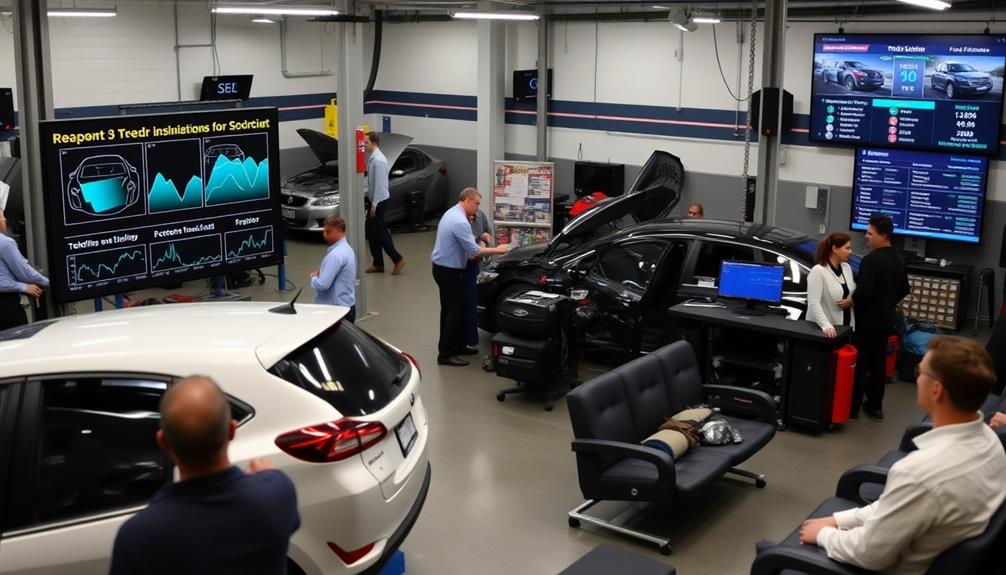
Driving the demand for automotive repairs are several interconnected factors that underscore the industry's resilience despite challenges. As the average age of light vehicles in the U.S. exceeds 12 years, older cars are more prone to mechanical issues, increasing the likelihood of repairs.
Additionally, global chip supply constraints limit new vehicle production, forcing you to rely on maintaining existing cars, which further escalates repair demand.
Consider these key drivers:
- The automotive technician shortage, with a need for over 100,000 new technicians annually until 2026.
- Rising motor vehicle repair costs, which have jumped nearly 20% in the past year due to supply chain challenges.
- The complexity of modern vehicle technology, necessitating skilled technicians for effective repairs.
- The growing presence of electric vehicles, which, while requiring less maintenance, still demand specialized services.
These factors shape the landscape of the auto repair industry, emphasizing the importance of customer service and the need for qualified professionals.
As you navigate this evolving environment, understanding these elements will help you appreciate the ongoing demand for automotive repairs.
Economic Challenges in Auto Repair
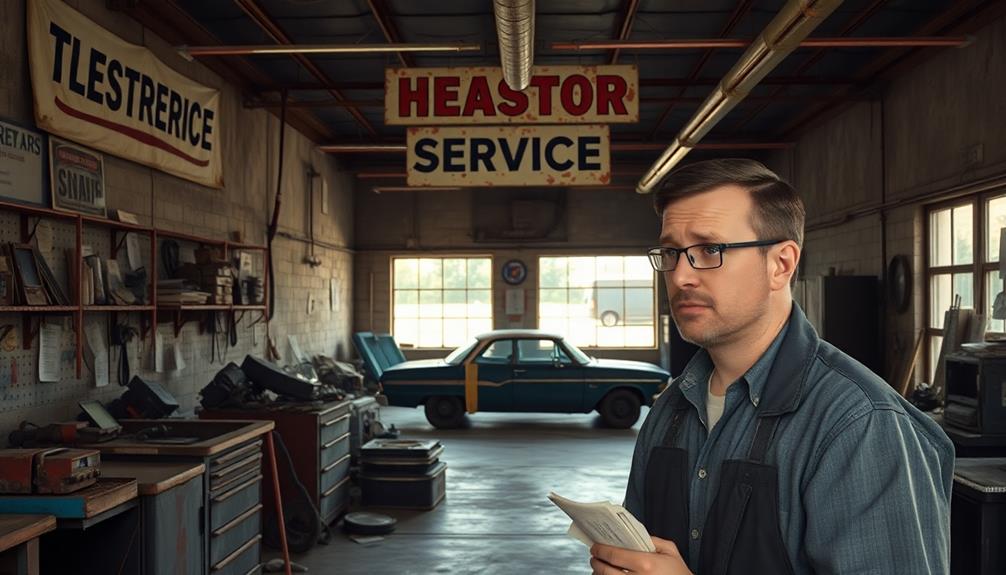
While the demand for automotive repairs remains strong, economic challenges are putting significant pressure on the industry. Numerous factors contribute to this troubling reality. The technician shortage is exacerbated by a 34% decrease in postsecondary program completions since 2012. With average technician salaries sitting 20% below the national average, attracting new talent into auto repair becomes increasingly difficult.
The rising number of repair costs—nearly 20% in just a year—highlights economic pressures stemming from supply chain issues and the complexity of high-tech vehicles. Consequently, you may experience longer wait times, as the average scheduling backlog has skyrocketed from 1.7 weeks in 2019 to 3.4 weeks today.
Here's a snapshot of the current challenges facing the industry:
| Challenge | Impact |
|---|---|
| Technician Shortage | Decreased service capacity |
| Rising Repair Costs | Increased customer frustration |
| Scheduling Backlog | Longer wait times for repairs |
| Supply Chain Issues | Delayed parts and service |
| Attracting New Talent | Ongoing workforce gap |
These economic pressures threaten the stability and future of the automotive repair industry, leaving you to wonder how long it can last.
Impact of Electric Vehicles
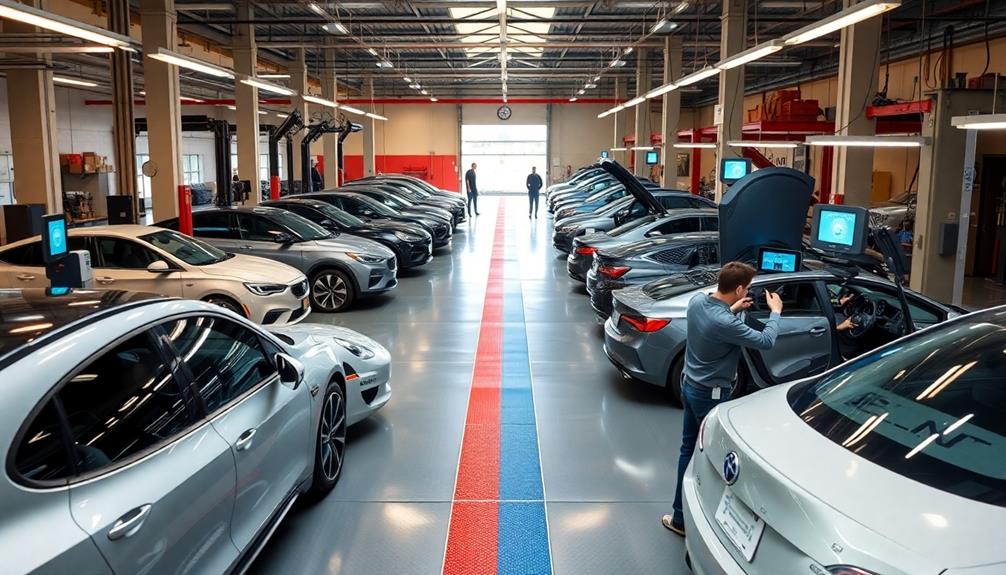
Transforming the automotive landscape, electric vehicles (EVs) are reshaping how we think about vehicle maintenance and repair. With EV sales projected to hit 40% of total sales by 2030, it's clear that the auto repair industry is in for significant changes.
While these electric cars require less maintenance than traditional gas-powered vehicles, the demand for skilled technicians won't vanish entirely. Here's what you need to know:
- Older vehicles, averaging over 12 years in age, still need frequent repairs.
- The complexity of EVs means that technicians must adapt to electronic and software diagnostics.
- Specialized training programs will become essential for those in the industry.
- The skills required for maintenance will shift, focusing more on technology than mechanics.
As the automotive repair industry evolves, technicians won't just be fixing engines; they'll be steering through intricate electronic systems.
This shift doesn't eliminate job opportunities; instead, it highlights the need for a new set of skills.
Future of the Repair Workforce
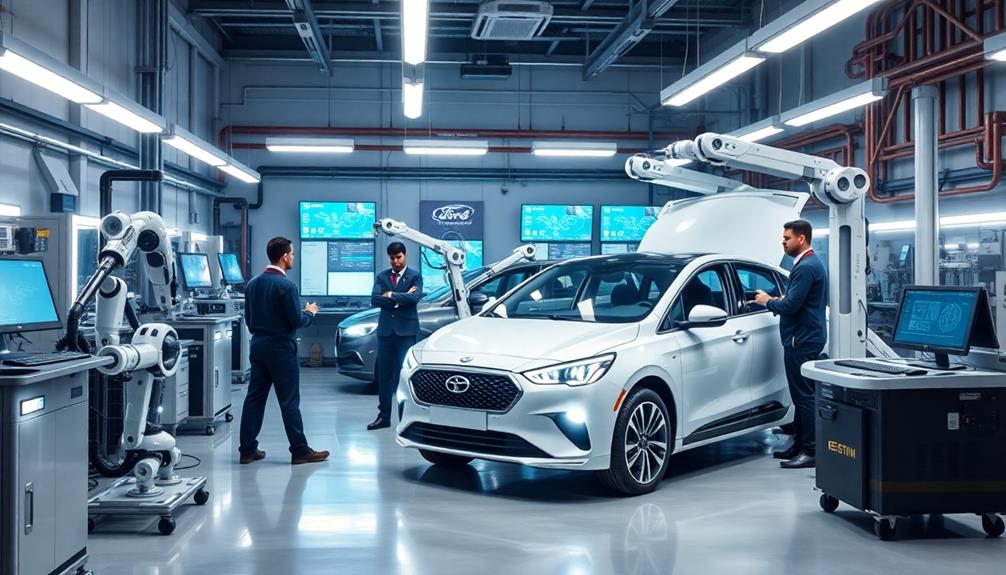
The automotive repair workforce's future hinges on addressing a pressing shortage of skilled technicians. With a projected need for over 100,000 new technicians annually through 2026, the industry faces a significant challenge.
A concerning 20% drop in automotive program graduates since 2020 has widened the gap between technician supply and market demand, which could exceed four times the number of graduates in the coming years.
As the average age of light vehicles in the U.S. surpasses 12 years, mechanical issues will likely increase, further fueling the need for skilled technicians.
However, traditional training programs are struggling to keep pace with the evolving complexity of modern vehicles. Technicians require ongoing education to handle advanced technology and diagnostics effectively.
Additionally, the rise of electric vehicles introduces new electronic repair requirements, necessitating specialized training for technicians.
This shift highlights the urgent demand for a skilled workforce capable of adapting to these industry changes.
To secure the future of automotive repair, investment in thorough training programs and outreach initiatives is essential to attract new talent and guarantee the industry can meet the growing demand.
Trends Shaping Auto Repair Shops

As you look at the automotive repair landscape, you'll notice a technician shortage that's causing serious challenges for shops.
Evolving vehicle technology means that repairs are taking longer, leaving customers frustrated with extended wait times.
With these trends shaping the industry, it's essential to understand how they impact both repair shops and vehicle owners.
Technician Shortage Crisis
A looming technician shortage is threatening the automotive repair industry, with over 100,000 new technicians needed each year to keep pace with rising demand. Unfortunately, only a fraction of graduates enters the field annually, exacerbating the crisis.
With the average age of light vehicles in the U.S. exceeding 12 years, the need for skilled technicians is more pressing than ever.
- Nearly half of shop owners are over 60, considering retirement.
- There's been a 20% drop in automotive program graduates since 2020.
- The average automotive technician salary lags 20% behind the national average.
- Demand for repairs is projected to exceed the number of new technicians by more than four times in the next five years.
These factors create significant recruitment challenges, leaving the automotive industry struggling to fill essential roles.
As retiring baby boomers exit the workforce, the gap in skilled labor widens, making it imperative to attract new technicians.
Without addressing these issues, you'll find the future of automotive repair increasingly uncertain, ultimately affecting the reliability of the cars you depend on daily. Without proactive solutions, the complexities of modern vehicles will make it more challenging for traditional repair shops to keep up with advancing technologies. By turning to specialized providers like Ferris Automotive Repair Services, drivers can ensure their cars are maintained using cutting-edge techniques and equipment. Investing in expert care now will help ensure smoother rides and fewer surprises down the road.
Evolving Vehicle Technology
With a technician shortage looming over the automotive repair industry, evolving vehicle technology is reshaping how repair shops operate.
As the average age of light vehicles in the U.S. exceeds 12 years, the demand for repairs remains high, especially since older vehicles break down more often. However, modern vehicles are increasingly software-defined, requiring auto technicians with advanced skills to tackle complex electronic systems. This shift is changing the workforce dynamic in repair shops.
The rise of electric vehicles (EVs) presents another challenge; while they require less routine maintenance, they also demand specialized knowledge and tools for repairs.
Advanced driver-assistance systems (ADAS) further complicate matters, as they require technicians to be equipped for calibration and diagnostics, increasing investment needs for repair shops.
As the complexity of repairs grows, so does the average repair duration, now up by 2.1 days from 2019 to 2021.
This trend leads to longer wait times and a backlog of service requests, forcing repair shops to adapt quickly to these new demands.
If you're in the industry, staying ahead of these trends is essential for your shop's success.
Repair Time Challenges
How are repair shops coping with the rising challenges of longer repair times? With the average scheduling backlog for vehicle repairs now at 3.4 weeks, auto repair shops are feeling the pressure. Delays in service are becoming the norm, and you might be wondering how they're managing.
To tackle these issues, shops are focusing on several strategies:
- Investing in specialized tools to handle modern vehicles
- Streamlining processes to reduce repair time
- Training and recruiting more auto technicians
- Enhancing customer communication regarding repair wait times
As repair durations have extended due to the intricate nature of vehicle technology, the technician shortage amplifies the problem.
Industry experts estimate that 10,000 to 20,000 new technicians are needed annually, driving repair wait times even higher. On top of that, pandemic-related supply chain issues only worsen the situation, making it critical for repair shops to adapt quickly.
In this evolving landscape, auto repair shops must innovate and invest wisely to overcome these repair time challenges, ensuring they can continue to serve their customers effectively.
Frequently Asked Questions
Is Auto Mechanic a Dying Trade?
You might think auto mechanics is a dying trade, but it's evolving. With rising vehicle complexity and increasing demand for skilled technicians, there's a bright future ahead for those willing to adapt and grow.
What Is the Future of the Auto Repair Industry?
The future of the auto repair industry looks promising. You'll see growth driven by vehicle complexity and technology advancements. Skilled technicians are in demand, and digital solutions will enhance customer experiences and service efficiency.
Why Are Mechanics Leaving the Industry?
You're watching experienced mechanics walk away, drawn to better pay and conditions elsewhere. The flat-rate model frustrates you, while training gaps leave new techs scarce. It's a tough landscape, leaving many feeling undervalued.
Are Mechanics Becoming Obsolete?
You might think mechanics are becoming obsolete, but the reality is different. As vehicles evolve, skilled technicians who adapt to new technologies and complexities are more crucial than ever, ensuring they remain vital in the industry.
Conclusion
So, is the automotive repair industry really dying? It seems ironic that while cars are getting more complex and need skilled technicians, fewer people are stepping up to fill those roles. You'd think with the rise of electric vehicles and new technology, auto repair would be booming. Instead, it's like watching a car stall right before the finish line. The future might just hold some surprises, but for now, the industry's pulse is a little faint.
